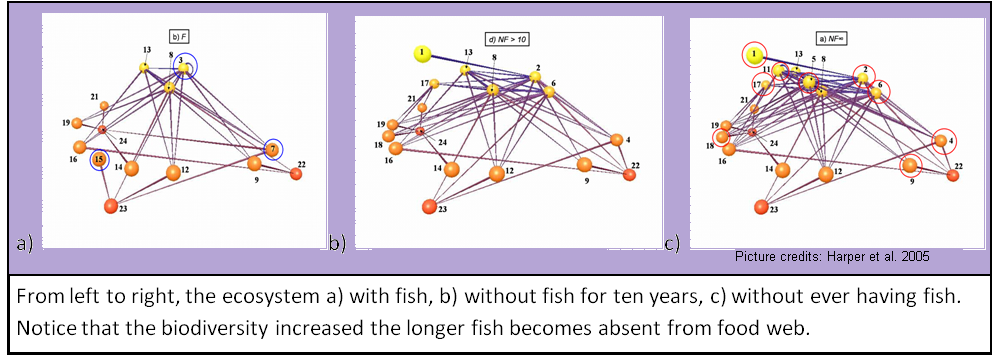The spheres and colors represent the various species and trophic levels respectively, in Nevada Lakes, USA. (Picture Credits: Harper et al. 2005).
Numbers are numbing and data are messy. “Visualization tools can help untangle complexity,” says Eric Berlow—ecologist at Sierra Nevada Research Institute in California. Good visualizations can bring out the details, organize information, and allow scientists to see data in a different way. A computer model called “Niche Model” emerged in the year 2000. It was developed by researchers of the applied mathematics department at Cornell University, Williams and Martinez. Before the model, many ecologists base their theories on “sharply focused” ecosystems with less species, to avoid “clutters” in their study. However, this was problematic since it risks oversimplifying real-world phenomena.
Since 2000, Niche Model injected a healthy dose of complexity into the field of ecology and conservation biology research. By embracing the complexity, ecologists can now generate more accurate predictions that mimic real ecosystems.
As we can see from the video, the computer model is more versatile than the traditional 2D food webs. Moreover, it only incorporate 2 variables—species (the spheres) and connectance (the lines). It allows scientists to remove species from the virtual food webs, and predict the impact on the overall ecosystem. Studies can now incorporate as many as 92 trophic levels (compare to 33 in year 2000) into a food web. It has advanced the quality of research by making large data sets more comprehensible.
Niche Model can also help us make fewer mistakes. Despite our best efforts, conservation movements often benefit one endangered species, while harming the rest. For example, in an effort to increase fish stockings, fishermen have begun released salmonoids into the Nevada lakes since 1900s. The result: trout population increased but biodiversity greatly decreased. Scientist argued that such result could have been anticipated with Niche Model.
In a paper titled “Communicating Ecology through Food Webs,” Harper et al. compared the projections from Niche Model with the aftermath of the salmonoid introduction (2005). After numerous statistical tests, these projections are deemed “similar” to the real-life system; they show the devastation that the ecosystem has endured.
In addition to estimating impacts, the model also generates useful visualizations that help scientists to communicate ecology to lay-people. The interdependencies of species within a food web become observable through graphs. Scientists are pushing the decision makers to consider the Niche Model before beginning another conservation campaign.
Of course, technologies must be used with care. Many people are concerned the capacity that the Niche Model could misinform. After all, the exact mechanism of why it predicts ecosystems so well is still guesswork. After years of rigorous research, however, more and more scientists are standing behind the Niche Model. In future, the Niche Model might show up in conference rooms, or even classrooms. With its help, scientists might be able to communicate ecology more accurately to more people.




One response to “Computer model brings better understanding of complex ecosystems”